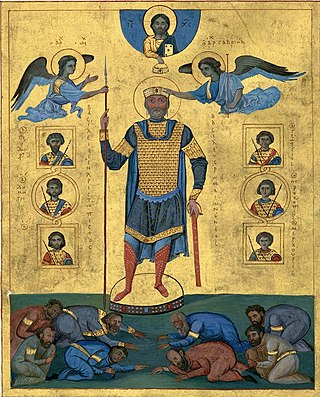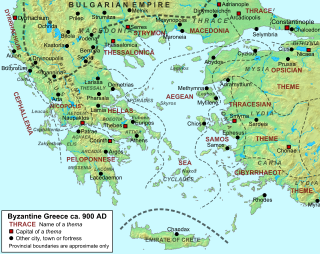
Basil II Porphyrogenitus, nicknamed the Bulgar Slayer, was the senior Byzantine emperor from 976 to 1025. He and his brother Constantine VIII were crowned before their father Romanos II died in 963, but they were too young to rule. The throne thus went to two generals, Nikephoros Phokas and John Tzimiskes before Basil became senior emperor, though his influential great-uncle Basil Lekapenos remained as the de facto ruler until 985. His reign of 49 years and 11 months was the longest of any Roman emperor.

The Battle of Kleidion took place on July 29, 1014, between the Byzantine Empire and the Bulgarian Empire. It was the culmination of the nearly half-century struggle between the Byzantine Emperor Basil II and the Bulgarian emperor Samuel in the late 10th and early 11th centuries. The result was a decisive Byzantine victory.

Miroslava was a Bulgarian-Byzantine noblewoman. She was the wife of Ashot Taronites, and daughter of tsar Samuil of Bulgaria and Agatha.
The Battle of Lemnos in 1024 was the culmination of a raid by Kievan Rus' troops through the Dardanelles and into the Aegean Sea. It was the penultimate conflict between the Byzantine Empire and the Rus'.

The Battle of Spercheios took place in 997 AD, on the shores of the Spercheios river near the city of Lamia in central Greece. It was fought between a Bulgarian army led by Tsar Samuil, which in the previous year had penetrated south into Greece, and a Byzantine army under the command of General Nikephoros Ouranos. The Byzantine victory virtually destroyed the Bulgarian army, and ended its raids in the southern Balkans and Greece. The major historical source on the battle comes from Greek historian John Skylitzes whose Synopsis of Histories contains a biography of the then-reigning Byzantine emperor, Basil II.

The Battle of Thessalonica occurred in 995 or earlier, near the city of Thessalonica, Greece. The battle was part of the long Bulgarian–Byzantine war of the late 10th and early 11th centuries. The Bulgarians under their ruler, Tsar Samuil, succeeded in ambushing and destroying the Byzantine garrison of Thessalonica, killing its commander, Gregory Taronites, and capturing his son Ashot.
Ivats or Ibatzes was a Bulgarian noble and military commander in the late 10th and early 11th centuries. He served three Bulgarian Emperors – Samuil (997–1014); Gavril Radomir (1014–1015) and Ivan Vladislav (1015–1018).
The Battle of Dyrrhachium in February 1018 was a part of the Byzantine–Bulgarian wars. It happened as the Bulgarian tsar Ivan Vladislav tried to establish his power on the southeastern coast of the Adriatic Sea. He led an army against Dyrrhachium and besieged it, but was killed during a counterattack of the city’s defenders.

From c. 970 until 1018, a series of conflicts between the Bulgarian Empire and the Byzantine Empire led to the gradual reconquest of Bulgaria by the Byzantines, who thus re-established their control over the entire Balkan peninsula for the first time since the 7th-century Slavic invasions. The struggle began with the incorporation of eastern Bulgaria after the Russo-Byzantine War (970–971). Bulgarian resistance was led by the Cometopuli brothers, who – based in the unconquered western regions of the Bulgarian Empire – led it until its fall under Byzantine rule in 1018.
Michael Bourtzes was a leading Byzantine general of the latter 10th century. He became notable for his capture of Antioch from the Arabs in 969, but fell into disgrace by the Emperor Nikephoros II Phokas. Resentful at the slight, Bourtzes joined forces with the conspirators who assassinated Phokas a few weeks later. Bourtzes re-appears in a prominent role in the civil war between Emperor Basil II and the rebel Bardas Skleros, switching his allegiance from the emperor to the rebel and back again. Nevertheless, he was re-appointed as doux of Antioch by Basil II, a post he held until 995, when he was relieved because of his failures in the war against the Fatimids.
Constantine Diogenes was a prominent Byzantine general of the early 11th century, active in the Balkans. He served with distinction in the final stages of the Byzantine conquest of Bulgaria under Emperor Basil II, and occupied high commands in the Balkans until his arrest in 1029, as the result of his participation in a conspiracy against Emperor Romanos III Argyros. Imprisoned and forced to enter a monastery, he killed himself in 1032 during an inquest on a further conspiracy. He was the father of Emperor Romanos IV Diogenes.
John Chryselios was a provincial magnate in late 10th-century Dyrrhachium, and the father-in-law of Tsar Samuel of Bulgaria.
Eustathios Maleinos was a leading Byzantine general and one of the wealthiest and most influential members of the Anatolian military aristocracy during the late 10th century. He held senior administrative and military posts in the East, and was involved in the aristocratic rebellions against Emperor Basil II, fighting against Bardas Skleros but supporting the revolt of his nephew Bardas Phokas. After the failure of the latter, he was not punished, but his immense wealth caused his eventual downfall, as Basil II confined him to a mansion in Constantinople and confiscated his wealth after his death.

The Theme of Dyrrhachium or Dyrrhachion was a Byzantine military-civilian province (theme), covering the Adriatic coast of modern Albania, and some coastal regions of modern Montenegro. It was established in the early 9th century and named after its capital, Dyrrhachium (Durrës).
Basil Argyros was a Byzantine nobleman and general of the Argyros family and a brother of the emperor Romanos III. Basil was the maternal grandfather of emperor Romanos IV Diogenes.

Gregory Taronites was an Armenian prince of Taron, who went over to Byzantine service and held senior commands and governorships under Emperor Basil II. He was killed by the Bulgarians at an ambush near Thessalonica ca. 991 or 995.
John Chaldos was a Byzantine general under Basil II.

Ashot Taronites was a Byzantine nobleman. Captured by the Bulgarians in 995, he was released in 996 and married to Miroslava, daughter of Tsar Samuel of Bulgaria. Appointed governor of Dyrrhachium by Samuel, he and his wife fled to Constantinople and arranged for Dyrrhachium to be handed over to Byzantine rule.

Nikephoros Komnenos was a Byzantine military leader under the emperors Basil II and Constantine VIII. He served as governor of the Armenian region of Vaspurakan, and is one of the first known members of the Komnenos family, which came to rule the Byzantine Empire in 1081–1185.
Michael Kourtikios was a senior Byzantine military commander and a partisan of Bardas Skleros during the latter's rebellion against Basil II.








